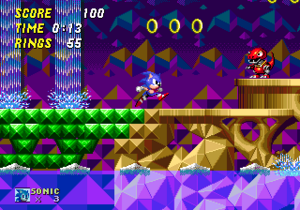Craig Stitt
From Sega Retro

|
| Craig Stitt |
|---|
| Place of birth: United States |
| Employment history:
Divisions:
|
| Role(s): Artist[1] |
| Education: San Jose State University (19xx-19xx; BA Art Education)[1] |
This short article is in need of work. You can help Sega Retro by adding to it.
Craig Stitt is an American art director and former Sega Technical Institute artist, known for his work on a number of the studio's Western-developed Mega Drive titles.[1]
Career
Craig Stitt's first job in the game industry was with Sega Technical Institute. He had been creating computer graphics for a couple of years, and one day came across a 1990 ad in the newspaper that read "Wanted: Videogame designers and artists, no experience necessary". Thankfully, he responded to the ad, and was officially hired as a game artist at STI later that year. His very first game would be the 1992 action platformer Kid Chameleon.[2] During his time with the company, he had a hand in creating artwork for a number of the studio's projects, including unreleased Mega Drive titles like Dark Empires, Jester, and Astropede, among others. He also did some minor work for Comix Zone and Kid Chameleon.[3]
Stitt's most well-known contribution to video gaming was his work on Sonic the Hedgehog 2. Acting as a level artist, he created artwork for a number of the game's Zones. While he was not directly responsible for designing any Zone layouts, he did occasionally have a hand in creative brainstorming in the design process. Stitt was provided with a Digitizer for creating his pixel art and a rudimentary paper map of a Zone layout, and once he created about a couple hundred tiles on the hardware, he would begin implementing them in the actual game. He recalls that some of his work was not included in the final release, including art of a clown/rollercoaster-themed Zone, alongside the famous Hidden Palace Zone, stating "if art had to get cut out it always seemed to be the American's on the team whos art got cut."[3]
Following Sonic 2, Stitt went about designing a mascot-platformer of his very own. Titled Astropede, it spent about 14 months in development before being permanently put "on hold". While described by Stitt as a "solid game", he feels it would have performed well if it had been better managed and actually released. Reportedly, Astropede was the only reason Stitt was remaining at Sega of America, and following its shelving in 1994, he was prompted to leave the company only one year later.[3] Following his departure from the company, Stitt accepted a position as Art Director at the Burbank, California-based developer Insomniac Games later that year.[1]
Production history
- Kid Chameleon (Mega Drive; 1992) — Art[4]
- Sonic the Hedgehog 2 (Mega Drive; 1992) — Zone Artists[5]
- Sonic the Hedgehog Spinball (Mega Drive; 1993) — Art[6]
- Comix Zone (Mega Drive; 1995) — Animation[7]
- The Ooze (Mega Drive; 1995) — Artists[8]
- Comix Zone (Windows PC; 1995) — Animation[7]
- Astropede (Mega Drive; unreleased) — Lead Designer
- Astropede (Mega Drive; unreleased) — Lead Artist
- Dark Empires (Mega Drive; unreleased) — Artist
- Jester (Mega Drive; unreleased) — Artists
- SpellCaster (Mega Drive; unreleased) — Designer
- Treasure Tails (Mega Drive; unreleased) — Artist
Interviews
- Interview: Craig Stitt (2001-01-23) by ICEknight
- Interview: Craig Stitt (2020-08-29) by Damiano Gerli
External links
References
- ↑ 1.0 1.1 1.2 1.3 1.4 1.5 1.6 1.7 1.8 1.9 https://www.linkedin.com/in/craig-stitt-5257bb97/
- ↑ https://www.youtube.com/watch?v=UOlHbBTF8eI
- ↑ 3.0 3.1 3.2 Interview: Craig Stitt (2001-01-23) by ICEknight
- ↑ File:Kid Chameleon MD credits.pdf
- ↑ File:Sonic the Hedgehog 2 MD credits.pdf
- ↑ File:Sonic Spinball MD credits.pdf
- ↑ 7.0 7.1 File:Comix Zone MD credits.pdf
- ↑ File:Ooze MD credits.pdf
